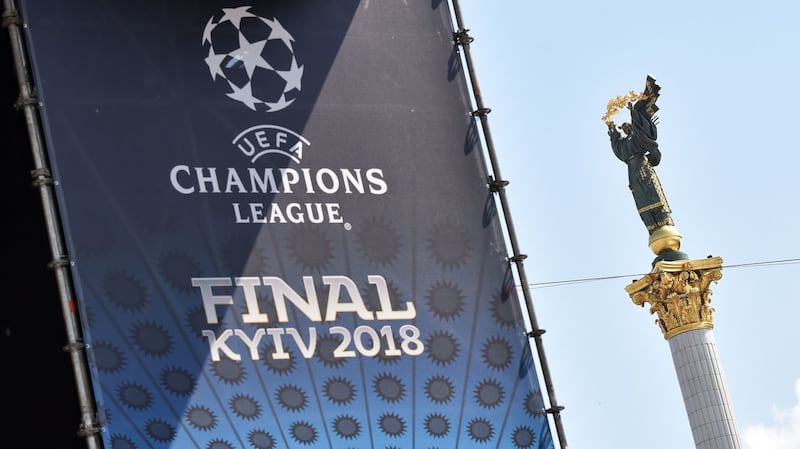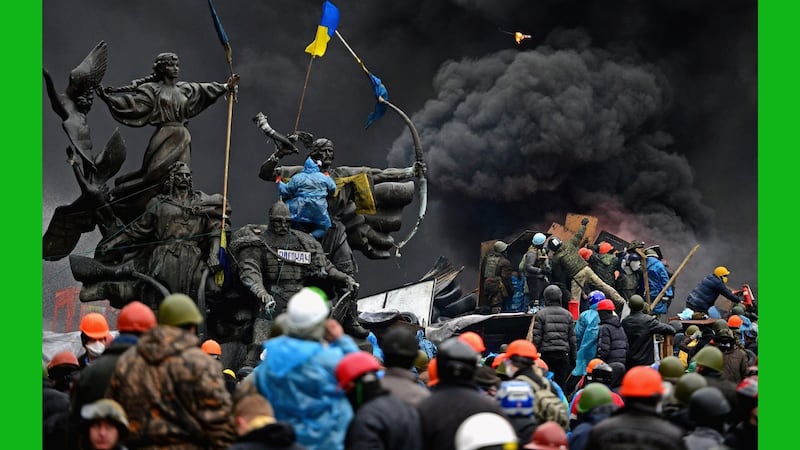The Khreschatyk boulevard in the centre of Kiev has transformed into a Uefa fan zone for the Champions League final. The fan zone looks the same as it always looks in every city: dark blue fences, ads for Uefa sponsors Pepsi and Lays wishing good luck to Liverpool and Real Madrid.
But you are soon reminded of where you are. The north end of the boulevard opens into a square and you see the banner draped across the massive facade of a building looming on the far side. A slogan, “Freedom Is Our Religion”, over the image of a breaking chain.
This is Kiev's Independence Square; in Ukrainian Maidan Nezalezhnosti. The building with the banner was once the Trade Unions building, but it was gutted by fire a little over four years ago, towards the end of the revolution that made the Maidan famous around the world.
This is the place where hundreds of thousands of protestors gathered and camped throughout the winter of 2013-14, united by their opposition to the government of Viktor Yanukovych, their despair with corruption and abuses of power and, as it turned out, not much else.
The Maidan protests culminated in the collapse of the government of Yanukovych, who fled to Russia, but not until more than 100 protestors, and 18 police officers, had been killed in a final paroxysm of violence.
Towering over the Maidan is the Independence Monument, a 200ft column that went up in 2001 to mark the 10-year anniversary of Ukraine’s independence from the Soviet Union.
Billboards
Arranged around the base of the pillar are concentric rows of billboards displaying photographs from the so-called Revolution of Dignity: the crowds, the barricades, the heroes, the blood. The accompanying texts are mostly in Cyrillic; it looks like the intended audience is the domestic one.

The street running up the hill off one side of the square, past the Hotel Ukraine, was known as Instytutska back in 2014. Now it is called the Avenue of the Heavenly Hundred Heroes. One side of the street is lined with framed pictures of the Maidan dead, the little shrines decorated by crosses, flowers, candles and poems.
This is where, in February 2014, the snipers rained down bullets on the crowd. Everyone knows the names of those who died. What is less clear is the identities of those who did the killing.
The official story is that the murders were carried out by security forces loyal to Yanukovych, particularly the Berkut special police unit, as part of a last desperate bid by the president to cling to his crumbling power. This is the story that toppled Yanukovych, and the memorials around Maidan are plainly designed to embed this account into history. A sign by the Independence Monument announces that the city is seeking architectural designs for a new museum to the Heavenly Hundred Heroes to be built on the square.
Extremist elements
And yet there are also those who claim that the violence was the work of extremist elements within the Maidan, aiming to provoke a fury that would sweep the government away. A 2015 paper by Ivan Katchanovski alleged that most of the snipers were agents of the far-right groups Svoboda ("Freedom") and Right Sector. A 2016 paper by Volodymyr Ishchenko at Kiev Polytechnic Institute concluded that these two groups had played the leading role in orchestrating violent confrontations between protestors and security forces at Maidan, and that the official account underplayed their influence. This is not as radical a claim as Katchanovski's, but it still feeds into the Russian line that the Revolution of Dignity was really a coup organised by neo-Nazis.
Trying to understand what happened at the Maidan shows how hard it is to know what to believe when faced with conflicting accounts of a situation you know very little about. Maybe talking to people here will make things a little clearer.
Along the former Instytutska Street there are many people selling braided bracelets in the Ukrainian colours of yellow and blue. They say they are raising money to send medical supplies to the Ukrainian soldiers in Donbass.

The first two I speak to are a man in his 60s and a woman in her 40s. The man says he is a retired army major. He says his son is in the air force in Donbass. He shows me his army pension book and the scar of a bullet wound in his shoulder.
Bullet holes
I ask what he thinks about the snipers. The man points out to me the pockmarks of bullet holes in nearby lampposts and trees. He points in the direction from which the bullets came – up Institutskaya, away from the Maidan. Who fired the bullets? “Berkut.” He has no doubt.
What do they think of the new president? The woman grimaces. “Poroshenko, not normal.” The man: “We had one revolution, two revolution. Maybe soon, three revolution.”
Down on the Maidan I speak to another bracelet seller, a man in his 20s. He speaks better English than the first two, but when I ask about the snipers, he struggles to find the words. He types on his phone, and shows me the translation.
“The Golden Eagle was bribed.”
This is mystifying until I see that Golden Eagle is the literal translation of Berkut. It’s clear our conversation is running up against its natural limits. Then he has the idea of calling his friend who speaks better English.
For a few minutes this friend describes how the protestors built barricades and camped here, creating a city within the city, until the men from Berkut started to shoot.
Suddenly he motions towards the centre of the square. “Let’s go over there, here there is too much sun.” It is rather hot.
I follow him over towards the Independence Monument. He turns to me and speaks in a low voice.
“I don’t want to talk near the van for TV news.”
I look back over to where we had been standing and I notice for the first time a van with the markings 1+1 and TSN.
Media conglomorate
1+1 is a big Ukrainian media conglomerate; TSN is their news network. Later, I look at the TSN website. The main story is about the latest developments in the international investigation into the shooting-down of MH-17. The investigators have found evidence that the fatal missile was fired by a Russian anti-aircraft system under the command of the 53rd anti-aircraft missile brigade. “In the Russian Federation, they try to blame others for a fatal catastrophe,” says TSN. The story details Russia’s history of MH-17 evasions, faked photographs, invented claims. Another story wonders if Putin will soon suffer the same fate as Gadaffi, whose history also included a destroyed civilian airliner.
“You want to know what I think?” the friend says. “Yanukovych, the old president. He is not stupid. This shootings, this did not suit him. It suits the president now, not then. They needed blood. They got blood. Yanukovych gone, new government.”
So wait. A minute ago you were telling me the opposite story. You’re saying this is the story you really believe?
“Hundred per cent. So now you know.”
Not really.
















